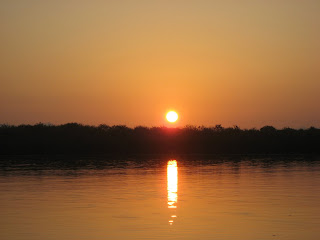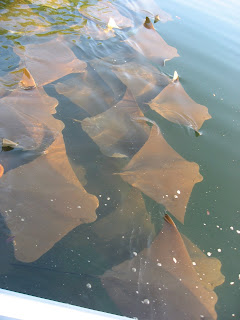

My Spanish teacher, Oscar, didn’t have time to prepare my lesson for this morning, having stayed up too late for the comedy club performance. So rather than reschedule the lesson, we decided to have a mobile lesson.
He started out by showing me the Montsenor, the café district, where locals like to go out for a couple of coffee. We stopped by an Italian café for a morning drink and pastry. While there, I saw a Mennonite man walk by, dressed in dark navy, neat overalls and a straw hat.
Oscar told me there are Mennonites here from the United States, Mexico, Germany and Canada. I asked about their relations with the local population.
“They used to be very closed and kept themselves separate,” he said. “They couldn’t marry Bolivians. But now there are two types. The conservatives continue as before. The revelados can marry Bolivians. They still maintain the clothing, but the spouse doesn’t have to.”
He also told me about some Japanese colonies near Santa Cruz, where almost the entire population is Japanese. His sister married one of these Japanese men. I’d like to visit one of the villages, as a Japanese world in the middle of Bolivia sounds pretty surreal to me.
We drove around town and Oscar helped me to orient myself a bit more. Santa Cruz is divided into rings. Ring 2 wraps around the center, ring three around ring two, and so on. Each ring is divided into different neighborhoods.
He told me that my neighborhood is called Equipetrol, which is known as a wealthy area. It was the first wealthy barrio in Santa Cruz. Now it’s known as a popular street hangout for young people. On Thursday through Saturday nights, they park trucks along the road and drink beer, blasting music from oversized speakers. It’s the kind of low-cost, 1980s, means of meeting other young people that I saw around the Minneapolis lakes growing up.
We drove across the Pirai river, which separates las Colinas del Urubo, the very wealthiest part of Santa Cruz, from the rest of town. Brown water flowed only through a very narrow part of the wide, brown bed. Oscar said that from December to February, it rained daily and the river was swollen. But now they are expecting a drought to follow and the water has largely dried up.
From the bridge, we could see the fancy white homes with red tiles of Urubo. I asked who lived there and Oscar said mostly owners or employees of petroleum and gas companies, cattle owners and large farmers.
We saw some residents biking on quality mountain bikes and a group of young people driving an open-air 4-wheel vehicle, for the fun of it.
“There are very large class differences here,” Oscar said. “We have both very rich and very poor.”
As we drove down the streets lined by the large-leaved chapeo tree and mango trees, Oscar pointed out to me a few of his favorite restaurants. Then we stopped by the zoo. The zoo has quite a good collection of tropical birds – 150 species and almost 1000 birds. Though the conditions for many are very side – small, square wire cages.
The macaws – the endangered blue-throated macaw, and the rainbow colored scarlet macaw, among others – screeched around us. Their sound couldn’t be contained in the little cages. They needed the vast expanse of a dense jungle to call across and to drown their desperate sounds.
I had to remember that while Santa Cruz is a sunny, plains town, we are actually quite close to the Amazon. Some of the animals were saw were purely fantastic, as though they’d come from a unique world of their own.
The quiet, black and white toucans, with huge, bright yellow beaks, tinged with red, were so perfectly groomed as to appear fake. The harpy eagle looked like a combination of an owl and an eagle, with huge claws of spun golden-brown threads. The Andean Condor was a larger than life-size bird in the vulture family. And my favorite of all was the sloth, a freaky looking creature with a small head, a runted tail, and long arms with strong, curved claws. It looks like a very primitive ape, or an ancient antecedent to the human. Due to its snail’s pace of movement, it was allowed to roam freely on the zoo grounds. Watching this creature move, one slow stretch at a time, disgusting and beautiful and captivating all at once, was the most fascinating thing I’ve seen in Santa Cruz so far.
In the evening, we ate at one of the nicest restaurants in Santa Cruz, el Candelabro. A combination French-sushi-piano bar place, we ate on finely covered tables by candlelight. This was a place where one could feast on gazpacho, grilled seafood, and chocolate cheesecake, the entrees served under platters that resembled medieval caps of armor. A group of waiters gathered around the table to reveal the entrees to the diners all at once, so there could be a collective exhale of awe. Again, not a scene I expected to encounter in Bolivia.
He started out by showing me the Montsenor, the café district, where locals like to go out for a couple of coffee. We stopped by an Italian café for a morning drink and pastry. While there, I saw a Mennonite man walk by, dressed in dark navy, neat overalls and a straw hat.
Oscar told me there are Mennonites here from the United States, Mexico, Germany and Canada. I asked about their relations with the local population.
“They used to be very closed and kept themselves separate,” he said. “They couldn’t marry Bolivians. But now there are two types. The conservatives continue as before. The revelados can marry Bolivians. They still maintain the clothing, but the spouse doesn’t have to.”
He also told me about some Japanese colonies near Santa Cruz, where almost the entire population is Japanese. His sister married one of these Japanese men. I’d like to visit one of the villages, as a Japanese world in the middle of Bolivia sounds pretty surreal to me.
We drove around town and Oscar helped me to orient myself a bit more. Santa Cruz is divided into rings. Ring 2 wraps around the center, ring three around ring two, and so on. Each ring is divided into different neighborhoods.
He told me that my neighborhood is called Equipetrol, which is known as a wealthy area. It was the first wealthy barrio in Santa Cruz. Now it’s known as a popular street hangout for young people. On Thursday through Saturday nights, they park trucks along the road and drink beer, blasting music from oversized speakers. It’s the kind of low-cost, 1980s, means of meeting other young people that I saw around the Minneapolis lakes growing up.
We drove across the Pirai river, which separates las Colinas del Urubo, the very wealthiest part of Santa Cruz, from the rest of town. Brown water flowed only through a very narrow part of the wide, brown bed. Oscar said that from December to February, it rained daily and the river was swollen. But now they are expecting a drought to follow and the water has largely dried up.
From the bridge, we could see the fancy white homes with red tiles of Urubo. I asked who lived there and Oscar said mostly owners or employees of petroleum and gas companies, cattle owners and large farmers.
We saw some residents biking on quality mountain bikes and a group of young people driving an open-air 4-wheel vehicle, for the fun of it.
“There are very large class differences here,” Oscar said. “We have both very rich and very poor.”
As we drove down the streets lined by the large-leaved chapeo tree and mango trees, Oscar pointed out to me a few of his favorite restaurants. Then we stopped by the zoo. The zoo has quite a good collection of tropical birds – 150 species and almost 1000 birds. Though the conditions for many are very side – small, square wire cages.
The macaws – the endangered blue-throated macaw, and the rainbow colored scarlet macaw, among others – screeched around us. Their sound couldn’t be contained in the little cages. They needed the vast expanse of a dense jungle to call across and to drown their desperate sounds.
I had to remember that while Santa Cruz is a sunny, plains town, we are actually quite close to the Amazon. Some of the animals were saw were purely fantastic, as though they’d come from a unique world of their own.
The quiet, black and white toucans, with huge, bright yellow beaks, tinged with red, were so perfectly groomed as to appear fake. The harpy eagle looked like a combination of an owl and an eagle, with huge claws of spun golden-brown threads. The Andean Condor was a larger than life-size bird in the vulture family. And my favorite of all was the sloth, a freaky looking creature with a small head, a runted tail, and long arms with strong, curved claws. It looks like a very primitive ape, or an ancient antecedent to the human. Due to its snail’s pace of movement, it was allowed to roam freely on the zoo grounds. Watching this creature move, one slow stretch at a time, disgusting and beautiful and captivating all at once, was the most fascinating thing I’ve seen in Santa Cruz so far.
In the evening, we ate at one of the nicest restaurants in Santa Cruz, el Candelabro. A combination French-sushi-piano bar place, we ate on finely covered tables by candlelight. This was a place where one could feast on gazpacho, grilled seafood, and chocolate cheesecake, the entrees served under platters that resembled medieval caps of armor. A group of waiters gathered around the table to reveal the entrees to the diners all at once, so there could be a collective exhale of awe. Again, not a scene I expected to encounter in Bolivia.
































